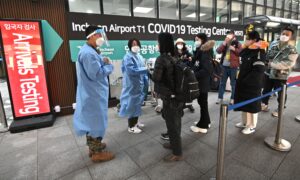South Korea has decided to extend its entry curbs on visitors from China, including its short-term visa restriction, until February amid fears that COVID-19 infections in the mainland may surge following the Lunar New Year celebration.
The visa restrictions on short-term Chinese travelers were initially set to be lifted at the end of this month, but the South Korean government has decided to push back the date to the end of February.
Health officials made the decision during a COVID-19 response meeting on Friday, citing concerns about a virus resurgence in South Korea if restrictions on Chinese visitors were lifted, given the mass gatherings that occur during the Lunar New Year holiday in China.
South Korea will also extend its requirement for Chinese travelers to provide a negative PCR test result before departure and after arrival through the end of February.
However, the South Korean Ministry of Health and Welfare said that it would consider easing its entry restrictions earlier if the outbreak situation in China improves, the Associated Press reported.
South Korea’s Disease Control and Prevention Agency reported that about 10 percent of the 6,900 short-term visitors from China who arrived in South Korea between Jan. 2 and Jan. 26 tested positive for the virus.
A woman and children wearing face masks walk by masked travelers wait at a departure hall to catch their trains at the West Railway Station in Beijing on Jan. 15, 2023. (Andy Wong/AP Photo)
The Chinese Communist Party (CCP) is expected to retaliate against the move, having previously banned the issuance of short-term visas to South Korean and Japanese nationals after the two countries imposed COVID-related entry restrictions on Chinese travelers.
Australia, Canada, Cyprus, France, India, Italy, Japan, Malaysia, South Korea, Qatar, Spain, the UK, and the United States are all implementing testing requirements on travelers from China, and the EU has sought to coordinate a response to the issue. [EPT]
CCP leadership has threatened “countermeasures” against all nations that move to implement the same type of restrictions on its travelers that it requires of theirs.
It remains unclear whether the regime will expand its visa suspensions to other nations that have imposed stricter virus testing on passengers from China.
China has seen a surge in COVID-19 cases across the country. Most of the population has been infected, according to officials and studies, and crematoriums and hospitals have been overwhelmed. But the regime’s continuing coverup of the death toll makes it difficult to ascertain the true scale of the outbreak.
Wu Zunyou, chief epidemiologist of China’s Disease Control and Prevention Center, stated on Jan. 21 that 80 percent of the population had been infected in the latest outbreak. His comment aligns with statements made by other Chinese officials in recent weeks and a study showing that 900 million Chinese had been infected.
People wait for medical attention at a fever clinic area in Tongren Hospital in the Changning district in Shanghai, on Dec. 23, 2022. (Hector Retamal/AFP via Getty Images)
Other countries were concerned about the CCP’s lack of transparency in sharing its COVID-19 data.
Last month, China’s National Health Commission (NHC) stopped publishing COVID infections and fatalities every day. The Chinese Center for Disease Control and Prevention, a department directly under NHC, publishes relevant outbreak information “for reference and research.”
China had only acknowledged 11 COVID deaths since Dec. 7, when the regime abruptly reversed course and loosened its strict zero-COVID policy. Health officials explained they only counted individuals dying from respiratory failure caused by COVID-19, excluding deaths from other diseases and conditions even if the deceased had tested positive for the virus.
“I believe the definition [of COVID death] in China is quite narrow,” Mike Ryan, emergencies director at the World Health Organisation, said at Dec. 21 briefing. Such criteria “will very much underestimate the true death toll associated with COVID,” he added.
Airfinity, a British-based health analytics firm, estimated as many as 9,000 people in China are probably dying each day from COVID. Cumulative deaths in China since Dec. 1 have likely reached 100,000 with infections totaling 18.6 million, researchers said on Dec. 29.
Dorothy Li, Andrew Thornebrooke, Reuters, and the Associated Press contributed to this report.



